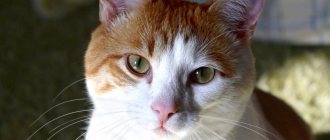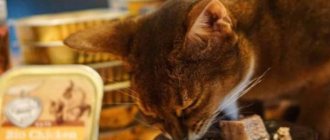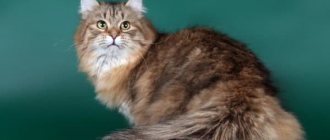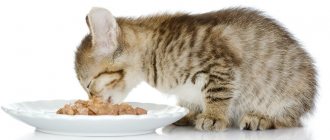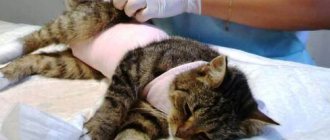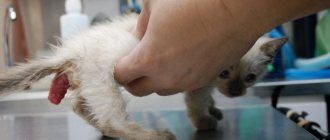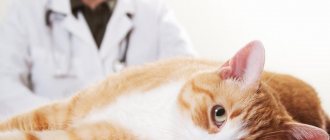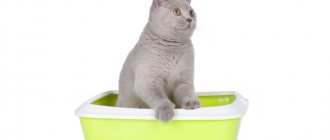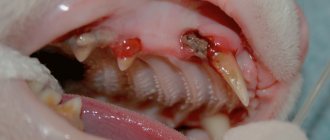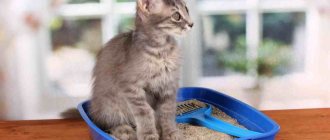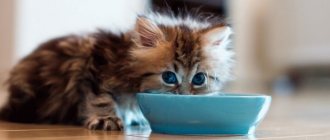Megacolon often occurs in cats as a result of pelvic injuries, deterioration of the nervous system, or stress. Doctors recommend contacting a veterinary clinic for advice immediately after detecting changes in the animal’s behavior. This will help avoid serious consequences such as lethargy or intestinal rupture. Pathology can be treated in two ways: surgery and drug therapy.
Reasons for appearance
Megacolon is a condition in kittens in which the colon becomes distended and overfilled. Thus, long-term constipation occurs. Defecation may be partial or completely absent. Quite often, the exact cause of the disease cannot be determined. This form of the disease is called idiopathic megacolon. But in this case, veterinarians say that the problem lies in the weakening of the muscle muscles. Another common factor is disruption of the integrity of the nerves, spinal cord, or narrowing of the pelvic bones. Such disorders are especially common in Manx cats.
According to veterinary surgeon Evgeniy Yuryevich Erasov, males are more susceptible to the disease (60-70%). At risk are cats from 5 to 8 years old.
Castrated males are more susceptible to pathology, as they lead a sedentary lifestyle and are more likely to suffer from excess weight. Less commonly, the sources are inflammatory processes or malignant neoplasms in the intestine. Sometimes the source of megacolon is poor diet, dehydration, or foreign bodies in the cat's intestines.
Often, pathology develops in a pet due to stress due to the need to share a tray with a fellow dog.
Sometimes household factors influence obstruction. For example, a cat may feel stressed or even frightened during relief. This may be due to competition for the litter box with other cats. Or the reason is that the toilet is located in an inconvenient place. The pet may experience discomfort associated with poor-quality litter or lack of cleanliness in the tray.
Causes of intestinal obstruction in cats
Intestinal obstruction occurs due to blockage of some part of the intestine, as a result of which gastric juice, feces and gases are not able to escape. This is a very dangerous condition that can lead to the death of the animal within a couple of days.
Juices in a cat's stomach are constantly produced. If there is a blockage in the intestines, they begin to accumulate in the stomach, which leads to vomiting. Many useful substances come out with the liquid, which leads to rapid dehydration of the body. The animal loses strength before our eyes.
Most often, the main cause of intestinal blockage is the ingestion of any large objects. However, obstruction can also develop against the background of other diseases.
The main causes of mechanical intestinal obstruction:
- Swallowing large objects . Cats are very curious, and they often try different objects to their teeth. However, not all of them are able to leave the body naturally. The most dangerous are: cellophane bags, rustling paper wrappers, New Year's tinsel, etc.
- Hairballs in the stomach . Cats lick themselves, and all the hair that falls out, especially during the molting period, ends up in the stomach. In most cases, the fur is easily removed on its own - this is what is associated with periodic vomiting in cats. There are times when a hairball begins to move further along the esophagus and stops the intestines.
- Infection with helminths . Although all stray cats suffer from worms to one degree or another, sometimes the situation can get significantly worse. Helminths multiply very quickly. They often stop various internal organs of the animal. The resulting lump of helminths can clog the intestines.
- Neoplasms in the intestines . A tumor does not have to be malignant to cause the death of an animal. Often the tumor grows slowly, and therefore the cat first begins to suffer from partial intestinal obstruction. The tumor will grow until it completely blocks the esophagus.
- Volvulus . One of the sections of the intestine is pinched. The situation is aggravated by the fact that necrosis of dying tissue is added to the obstruction.
- Hernia . In some cases, part of the intestine may prolapse into the abdominal cavity. It is compressed by tissues, which can lead to tissue necrosis and intestinal obstruction.
- Constipation . Poor nutrition leads to stool becoming increasingly dry. They have difficulty passing through the intestines. This can lead first to constipation, and then to the formation of fecal impaction.
In addition to mechanical, there is also dynamic intestinal obstruction. It is not associated with mechanical blockage of the intestines, but with a violation of intestinal contractions.
The main causes of dynamic intestinal obstruction:
- Abdominal surgery performed.
- Other serious diseases: ascites, peritonitis, lead to paralysis of the intestinal walls.
- Spinal injury.
- Poor circulation in the abdominal area.
- A strong spasm leads to compression of the intestinal muscle. In this case, the animal feels very severe pain. Spasm can be caused by inflammatory diseases (enteritis, enterocolitis), or severe mechanical trauma to the abdominal cavity.
You might be interested in: What can cause a cat's face to swell?
Symptoms of the disease
Against the background of such a pathology, the pet stops eating.
Common signs of the disease are associated with disruption of the process of fecal excretion. The cat may try to go to the toilet for a long time and return the tray several times. Sometimes she stops trying completely. In the first stages, involuntary bowel movements are possible. At a later stage, blood or mucus may be released along with the stool. This is a clear sign of an inflammatory process. Unlike diarrhea, stool is dry. Sometimes cats suffer from vomiting. There is a sharp decrease in weight, loss of appetite and dehydration. The cat becomes nervous and restless. If the origin of the disease lies in a disruption of the nervous system, then involuntary urination appears. Without treatment, megacolon in cats can lead to intestinal rupture or even lethargy.
Differential diagnoses
Several authors have emphasized the importance of considering an extensive list of differential diagnoses (eg, neuromuscular, mechanical, inflammatory, metabolic/endocrine, pharmacologic, environmental, and behavioral causes) for cats not responding to therapy.
However, a review of published cases suggests that 96% of cases of colonic dysmotility are idiopathic megacolon (62%), pelvic canal stenosis (23%), nerve injury (6%), or spinal cord deformity (5%).
A minority of cases are due to complications of colopexy (1%) and colonic neoplasia (1%); subacute hypo- or aganglionosis is suspected, but cannot be proven, in the other 2% of cases.
Inflammatory, pharmacologic, and environmental/behavioral causes were not identified as predisposing factors in any of the original case reports.
Endocrine factors (obesity, n = 5, hypothyroidism, n = 1) were cited in several cases but were not necessarily considered part of the pathogenesis of megacolon.
Diagnostic methods
It is important to conduct a full examination, since the symptoms of megacolon are similar to those of helminthic infestations. First, the doctor listens to the complaints of the cat's owners. The pet's medical history is examined, as this helps determine the cause of megacolon. The animal is prescribed a biochemical test of blood, urine and feces. Pay attention to the functioning of the thyroid gland, since hormones can influence the development of the disease.
Pathology is best diagnosed using x-ray.
X-rays are taken to identify the location of constipation. Before such an examination, the cat is fed barium porridge, as it is clearly visible on an x-ray. Thus, the doctor can more accurately determine the location of stagnation. In severe cases, a colonoscopy is performed under general anesthesia. A neurological examination is performed using computed tomography. Additionally, an ultrasound examination of the abdominal cavity is prescribed.
Treatment of the disease
There are 2 main methods of getting rid of megacolon - surgical and conservative. The choice of therapy depends on the severity of the disease. The main goals of treatment are cleansing the intestines, restoring metabolism and quality hydration. In the early stages, the cat may self-heal.
Drugs against megacolon
Doctors prescribe medications that help improve the passage of stool through the intestines. Vaseline oil has an effective effect. It is best administered rectally to avoid causing aspiration pneumonia. Hypersomatic laxatives (potassium salts, lactulose, polyethylene glycols) help improve metabolism and speed up the movement of food through the body.
The following drugs can be used in the treatment of this disease: Lactulose and Cisapride.
It is safest to use lactulose. It is suitable for all cats. Magnesium salts are contraindicated in individuals who have kidney problems. Glycols negatively affect the health of a cat if it has intestinal obstruction. To improve the functioning of the gastrointestinal tract, prokinetics are used. The drug "Cisapride" will restore your pet's appetite. To cleanse the body, you need to do an enema. If this method does not help, then the feces are removed manually. To do this, the cat is given more fluids and then an anesthetic is administered through an endotracheal tube to reduce discomfort. This will help inject a saline solution into the anus and remove the stones.
The disease can be treated with the following drugs:
- "Ranithiin" (1-2 milligrams per kilogram every 10 hours);
- "Nizatidine" (2-5 mg/kg per day);
- "Tsufulak" (15 mg/kg at 12 o'clock);
- "Duclolax" (5 mg per 24 hours);
- "Laxaton" (1-5 ml per day).
Surgical method
Elimination of the pathology by surgery is necessary when it is severe.
In case of severe stage of the disease, subtotal colectomy is used. This is an operation in which part of the intestine is cut out from the body. The effectiveness of this method depends on the stage of development of the disease. Sometimes after the intervention the cat has loose stools for a month. But this method also gives the cat a better chance of recovery than the drug method. Colonopexy is also performed. This is a surgical procedure in which the intestine is fixed to the abdominal wall. This helps relieve constipation.
Diet for megacolon
It is important that the animal always has access to a tray and bowl of food. To restore water balance, a lot of water is required. The diet should consist of dietary wet food. The food should contain a large amount of fiber and water. This will help it be absorbed faster and pass through the entire body. To restore the animal’s strength, it is recommended to give a complete complex of vitamins and minerals.
Diagnosis and treatment of megacolon in animals
Treatment methods are prescribed by a veterinarian after conducting comprehensive diagnostic studies. The final diagnosis is made based on the results of ultrasound of the peritoneum. On palpation, an enlarged colon can be clearly felt. On rectal examination, accumulation of hard stool is noted.
Treatment of megacolon is carried out surgically or conservatively, and before surgery, in most cases, animals will be prescribed symptomatic treatment of constipation, aimed at eliminating the root cause. First of all, it is necessary to eliminate the symptoms of dehydration, intoxication, and also free the intestinal lumen from feces.
The intestines are cleansed with an enema or manual method under general anesthesia. To avoid constipation in the future, cats are prescribed a therapeutic diet and a diet is selected that contains foods containing fiber. Animals may be prescribed laxatives, enemas, probiotics, enzyme preparations, prokinetics (cisapride). With conservative treatment, the prognosis is acute.
Important! Positive dynamics are noted after the appointment of Bisocodil. This drug is prescribed to cats only for secondary, idiopathic megacolon.
The best result is observed after a surgical operation - subtotal colectomy. During surgery, the entire large intestine will be removed with the exception of a small distal section, which is necessary to restore the integrity of the intestinal tract.
The operation is performed using two methods: with removal of the ileocecal valve, which is located at the transition of the small intestine to the large intestine, and without. If the valve is preserved, the risk of relapse increases. If the colon is completely removed, the small intestine becomes contaminated with pathogenic flora, which can cause frequent diarrhea, which is difficult to treat.
Despite the fact that veterinarians rarely diagnose the disease, this pathology significantly worsens the quality of life of animals. At the same time, thanks to modern techniques, the disease can be kept under control. A radical solution to the problem involves only surgery.
Megacolon is a pathology that is characterized by passive enlargement and dilation of certain parts of the large intestine. We are talking about the colon and rectum. This pathology may be associated with mechanical obstruction or functional impairment. Megacolon in dogs can be congenital or acquired. Recognition of the congenital form of the disease is rare.
Etiology and pathogenesis
Mechanical obstruction of the intestine occurs due to the following reasons: 1. The presence of a foreign body. 2. Tumor lesion of the colon or rectum. 3. Chronic constipation. 4. Narrowing of the pelvic canal as a result of fractures, enlarged prostate, or tumor process.
The cause of functional disorders is a disorder of the pelvic nerves as a result of a hereditary defect or inflammatory lesion. Note that cats often develop idiopathic megacolon.
Acquired megacolon in dogs is characterized by disruption of the smooth muscles of the colon. As a result, intestinal motility changes. This is manifested by symptoms such as subsequent constipation, obstruction and distension of the colon. The development of functional abnormalities may be associated with persistent constipation. Fecal retention is characterized by the removal of water from them. As a result, the feces thicken. Clinical picture of the disease
As a rule, megacolon in dogs is preceded by traumatic injury to the pelvis, prostate pathology, and chronic episodes of constipation. Difficulty in defecation is typical. The disease is also manifested by refusal to eat, vomiting, dehydration, and behavioral disturbances in the form of lethargy.
Diagnostics
Palpation reveals an enlarged colon. Rectal examination helps to identify the main causes of the disease: 1. Anal constrictions. 2. Narrowed pelvic canal. 3. Increase in the size of the prostate and regional lymph nodes. 4. Pathology of the vagina or urinary tract.
X-rays reveal dilation of the colon with the presence of dense feces, foreign objects, traumatic damage to the pelvis, enlargement of neighboring organs, and spinal defects. In rare cases, the use of colonoscopy is indicated, which consists of examining the colon and taking samples for research.
Megacolon in dogs and cats must be distinguished from inflammation of the colon and rectum.
Treatment of the disease
To stabilize the animal's condition, infusion therapy is performed. To remove dense feces, use enemas with warm water. If such treatment is ineffective, feces are removed under general anesthesia.
The fight against the main causes of the disease is envisaged. To restore intestinal motility, fiber foods are added to the dog's diet. The use of laxatives is also recommended. We are talking about lactulose, dioctyl. Erythromycin is used to stimulate intestinal motility. Cisapride is used to prevent the progression of the disease in cats.
In severe cases, the colon is removed with the formation of additional connections (anastomoses). The indication for this is the ineffectiveness of conservative treatment. Note that such an operation is performed only for megacolon of unknown origin. In most cases, surgery eliminates all difficulties during bowel movements.
Surgical treatment of idiopathic megacolon in cats significantly improves prognosis.
And it is easily eliminated with supportive fluid administration, oral, nutritional or parenteral agents. Persistent constipation (obstipation) is severe constipation that cannot be treated. Persistent constipation involves permanent loss of bowel movements. If constipation leads to expansion or hypertrophy of the colon, then this condition is called megacolon.
Extended megacolon is the terminal stage of idiopathic colon dysfunction. The result of the disease is diffuse dilation of the colon and decreased peristalsis.
Hypertrophic megacolon is the result of malunion of a pelvic fracture and pelvic canal stenosis or other condition (including polyps or foreign body) that obstructs the passage of stool. Colon obstruction is the accumulation of hardened stool in the pelvic area and is a consequence of constipation, persistent constipation, or megacolon.
Dr. Robert Washabaugh and his team have studied megacolon in cats, and their findings confirm that the underlying problem with megacolon is disruption of the smooth functioning of the intestines.
